University Market Research Project Report: Blood Donation Rates
VerifiedAdded on 2023/06/03
|26
|5016
|227
Report
AI Summary
This market research project investigates the opportunities and barriers within voluntary blood donation rates in Australia. The study explores the motivations and barriers to blood donation among the Australian population. The research examines the segmentation of the population based on socio-psychological perspectives, motivational factors, and barriers to blood donation. It also analyzes the influence of media and communication channels on potential donors. The research employed a non-probability convenience sampling approach, collecting survey data from 276 participants within a capital city in Australia. The findings reveal that fear of blood transmissible diseases is a significant deterrent for blood donation. Additionally, the study highlights the influence of social and communal information channels like friends, family, and social cultures in motivating potential blood donors. The report includes an introduction, literature review, research aims and objectives, methodology, results and discussion, and conclusions with recommendations and limitations. The research aims to identify motivators and barriers for blood donation, understand the decision-making processes of donors, and determine effective communication channels to enhance blood donation rates.
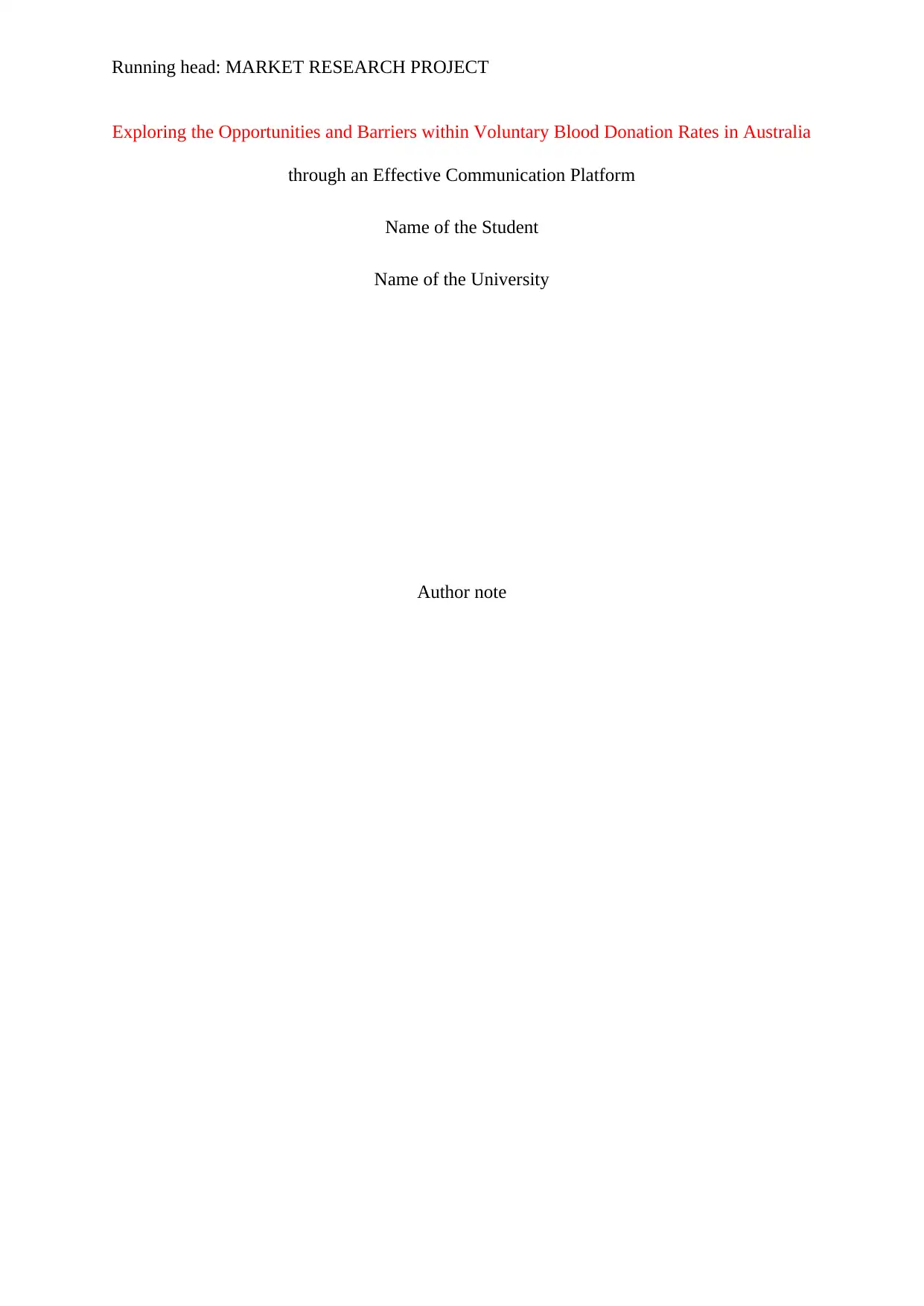
Running head: MARKET RESEARCH PROJECT
Exploring the Opportunities and Barriers within Voluntary Blood Donation Rates in Australia
through an Effective Communication Platform
Name of the Student
Name of the University
Author note
Exploring the Opportunities and Barriers within Voluntary Blood Donation Rates in Australia
through an Effective Communication Platform
Name of the Student
Name of the University
Author note
Paraphrase This Document
Need a fresh take? Get an instant paraphrase of this document with our AI Paraphraser
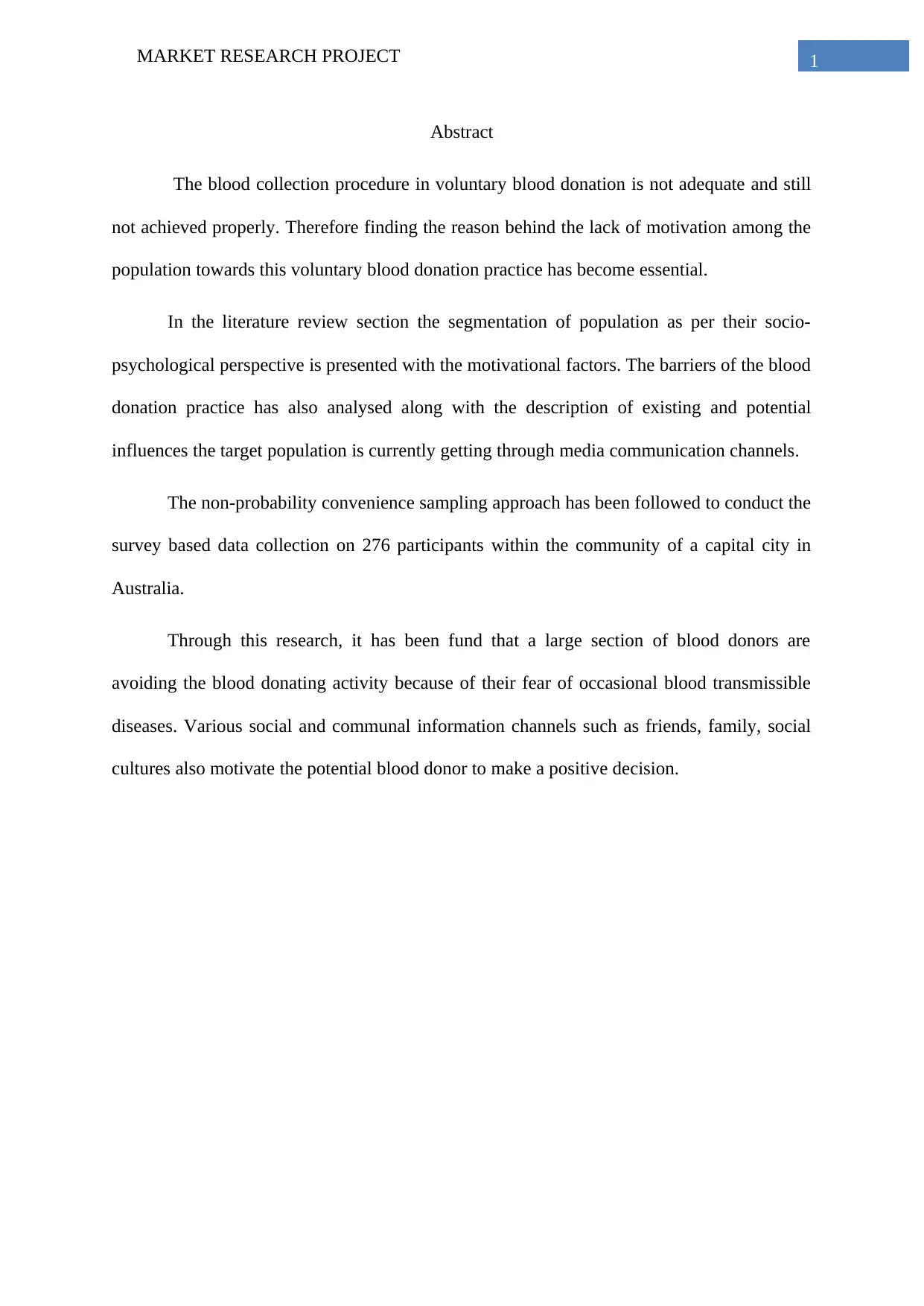
1MARKET RESEARCH PROJECT
Abstract
The blood collection procedure in voluntary blood donation is not adequate and still
not achieved properly. Therefore finding the reason behind the lack of motivation among the
population towards this voluntary blood donation practice has become essential.
In the literature review section the segmentation of population as per their socio-
psychological perspective is presented with the motivational factors. The barriers of the blood
donation practice has also analysed along with the description of existing and potential
influences the target population is currently getting through media communication channels.
The non-probability convenience sampling approach has been followed to conduct the
survey based data collection on 276 participants within the community of a capital city in
Australia.
Through this research, it has been fund that a large section of blood donors are
avoiding the blood donating activity because of their fear of occasional blood transmissible
diseases. Various social and communal information channels such as friends, family, social
cultures also motivate the potential blood donor to make a positive decision.
Abstract
The blood collection procedure in voluntary blood donation is not adequate and still
not achieved properly. Therefore finding the reason behind the lack of motivation among the
population towards this voluntary blood donation practice has become essential.
In the literature review section the segmentation of population as per their socio-
psychological perspective is presented with the motivational factors. The barriers of the blood
donation practice has also analysed along with the description of existing and potential
influences the target population is currently getting through media communication channels.
The non-probability convenience sampling approach has been followed to conduct the
survey based data collection on 276 participants within the community of a capital city in
Australia.
Through this research, it has been fund that a large section of blood donors are
avoiding the blood donating activity because of their fear of occasional blood transmissible
diseases. Various social and communal information channels such as friends, family, social
cultures also motivate the potential blood donor to make a positive decision.
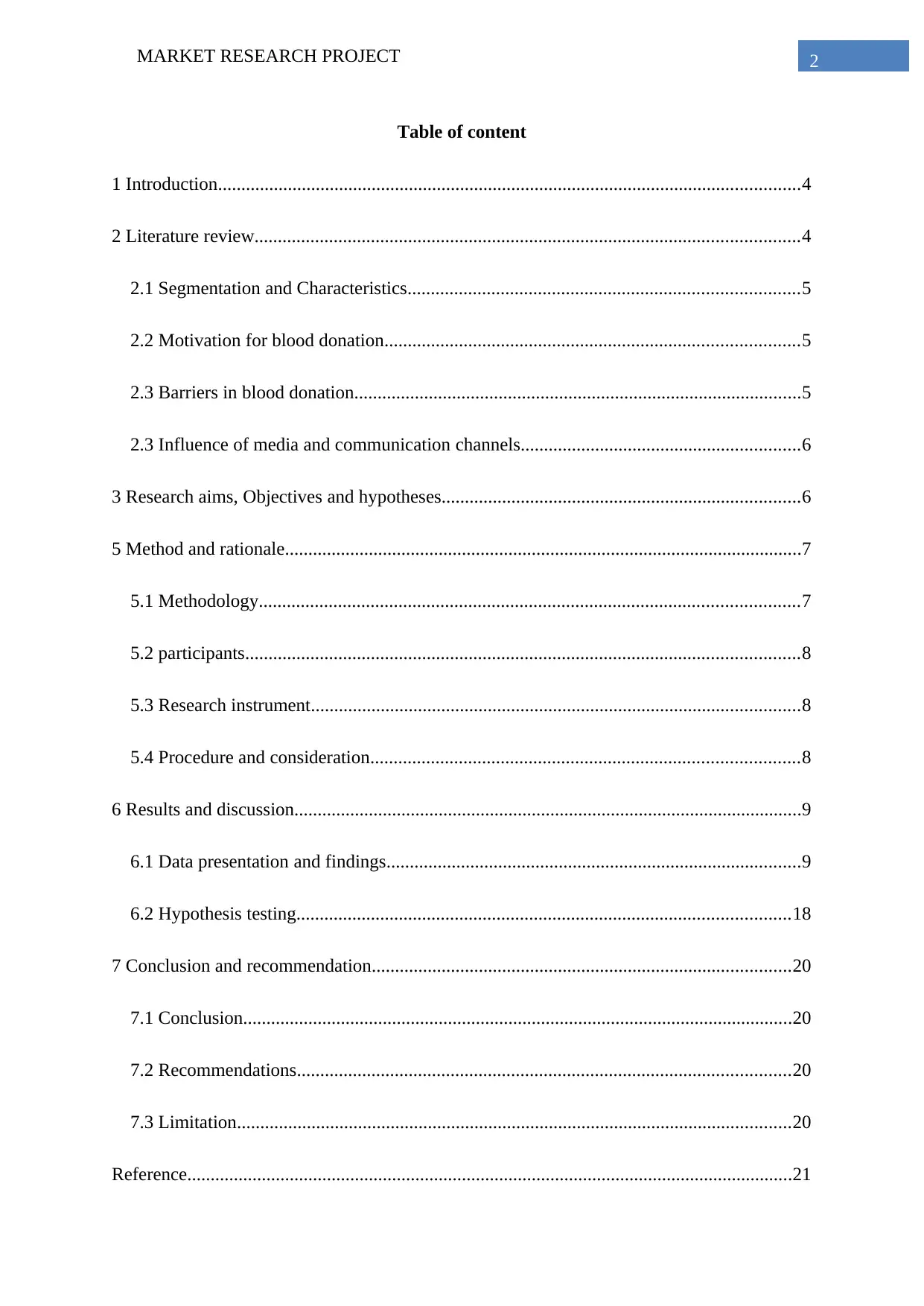
2MARKET RESEARCH PROJECT
Table of content
1 Introduction.............................................................................................................................4
2 Literature review.....................................................................................................................4
2.1 Segmentation and Characteristics....................................................................................5
2.2 Motivation for blood donation.........................................................................................5
2.3 Barriers in blood donation................................................................................................5
2.3 Influence of media and communication channels............................................................6
3 Research aims, Objectives and hypotheses.............................................................................6
5 Method and rationale...............................................................................................................7
5.1 Methodology....................................................................................................................7
5.2 participants.......................................................................................................................8
5.3 Research instrument.........................................................................................................8
5.4 Procedure and consideration............................................................................................8
6 Results and discussion.............................................................................................................9
6.1 Data presentation and findings.........................................................................................9
6.2 Hypothesis testing..........................................................................................................18
7 Conclusion and recommendation..........................................................................................20
7.1 Conclusion......................................................................................................................20
7.2 Recommendations..........................................................................................................20
7.3 Limitation.......................................................................................................................20
Reference..................................................................................................................................21
Table of content
1 Introduction.............................................................................................................................4
2 Literature review.....................................................................................................................4
2.1 Segmentation and Characteristics....................................................................................5
2.2 Motivation for blood donation.........................................................................................5
2.3 Barriers in blood donation................................................................................................5
2.3 Influence of media and communication channels............................................................6
3 Research aims, Objectives and hypotheses.............................................................................6
5 Method and rationale...............................................................................................................7
5.1 Methodology....................................................................................................................7
5.2 participants.......................................................................................................................8
5.3 Research instrument.........................................................................................................8
5.4 Procedure and consideration............................................................................................8
6 Results and discussion.............................................................................................................9
6.1 Data presentation and findings.........................................................................................9
6.2 Hypothesis testing..........................................................................................................18
7 Conclusion and recommendation..........................................................................................20
7.1 Conclusion......................................................................................................................20
7.2 Recommendations..........................................................................................................20
7.3 Limitation.......................................................................................................................20
Reference..................................................................................................................................21
⊘ This is a preview!⊘
Do you want full access?
Subscribe today to unlock all pages.

Trusted by 1+ million students worldwide
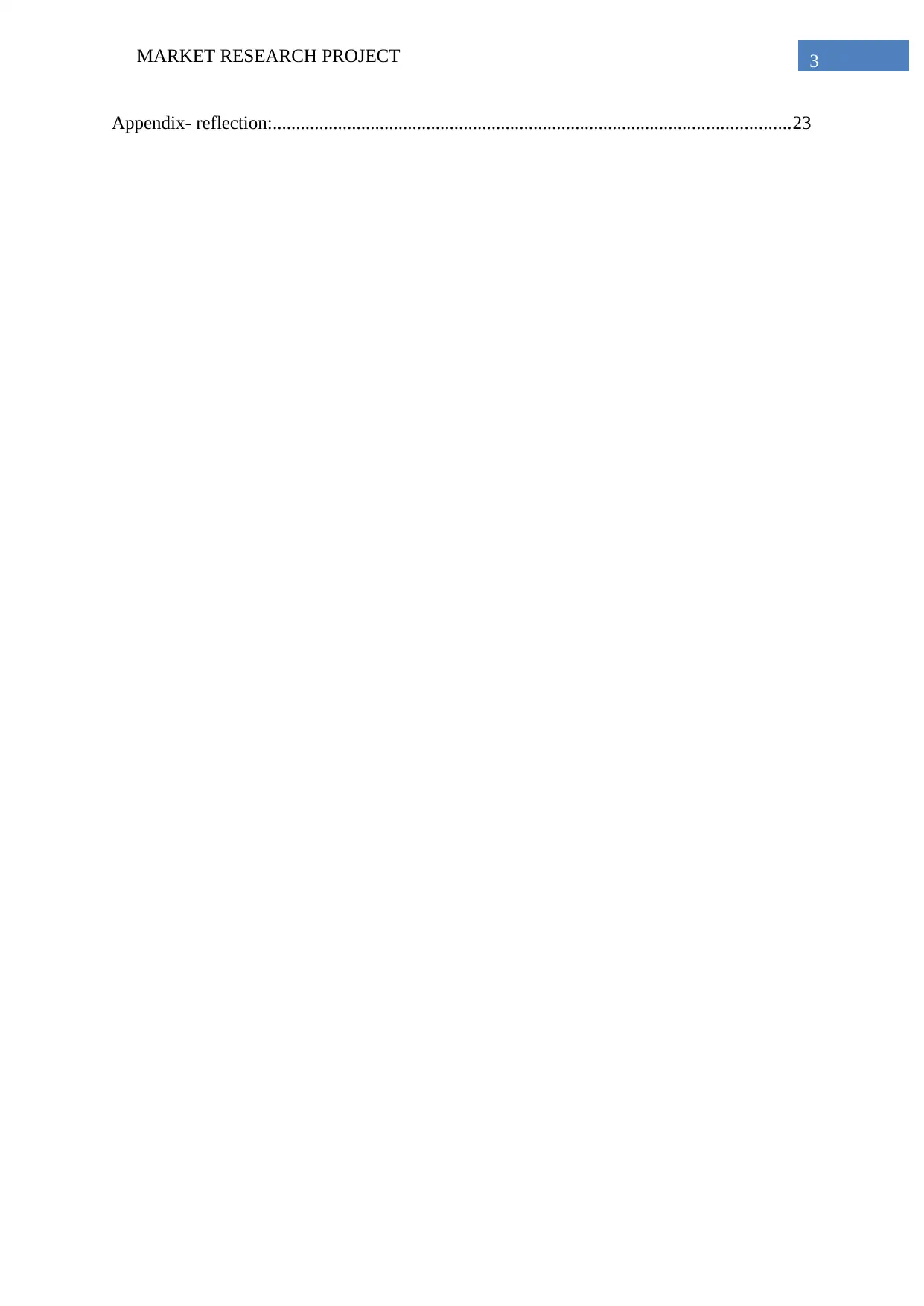
3MARKET RESEARCH PROJECT
Appendix- reflection:...............................................................................................................23
Appendix- reflection:...............................................................................................................23
Paraphrase This Document
Need a fresh take? Get an instant paraphrase of this document with our AI Paraphraser
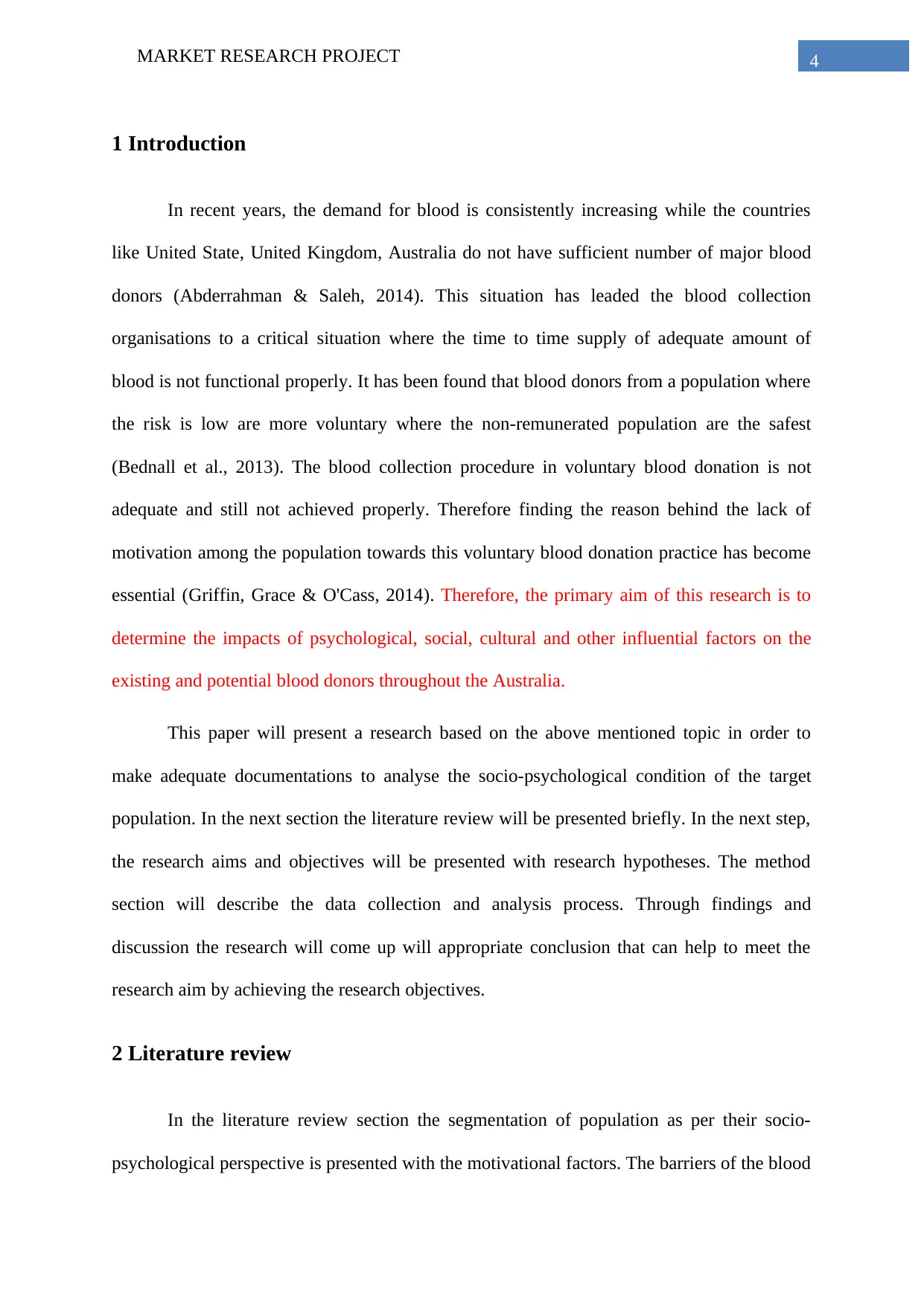
4MARKET RESEARCH PROJECT
1 Introduction
In recent years, the demand for blood is consistently increasing while the countries
like United State, United Kingdom, Australia do not have sufficient number of major blood
donors (Abderrahman & Saleh, 2014). This situation has leaded the blood collection
organisations to a critical situation where the time to time supply of adequate amount of
blood is not functional properly. It has been found that blood donors from a population where
the risk is low are more voluntary where the non-remunerated population are the safest
(Bednall et al., 2013). The blood collection procedure in voluntary blood donation is not
adequate and still not achieved properly. Therefore finding the reason behind the lack of
motivation among the population towards this voluntary blood donation practice has become
essential (Griffin, Grace & O'Cass, 2014). Therefore, the primary aim of this research is to
determine the impacts of psychological, social, cultural and other influential factors on the
existing and potential blood donors throughout the Australia.
This paper will present a research based on the above mentioned topic in order to
make adequate documentations to analyse the socio-psychological condition of the target
population. In the next section the literature review will be presented briefly. In the next step,
the research aims and objectives will be presented with research hypotheses. The method
section will describe the data collection and analysis process. Through findings and
discussion the research will come up will appropriate conclusion that can help to meet the
research aim by achieving the research objectives.
2 Literature review
In the literature review section the segmentation of population as per their socio-
psychological perspective is presented with the motivational factors. The barriers of the blood
1 Introduction
In recent years, the demand for blood is consistently increasing while the countries
like United State, United Kingdom, Australia do not have sufficient number of major blood
donors (Abderrahman & Saleh, 2014). This situation has leaded the blood collection
organisations to a critical situation where the time to time supply of adequate amount of
blood is not functional properly. It has been found that blood donors from a population where
the risk is low are more voluntary where the non-remunerated population are the safest
(Bednall et al., 2013). The blood collection procedure in voluntary blood donation is not
adequate and still not achieved properly. Therefore finding the reason behind the lack of
motivation among the population towards this voluntary blood donation practice has become
essential (Griffin, Grace & O'Cass, 2014). Therefore, the primary aim of this research is to
determine the impacts of psychological, social, cultural and other influential factors on the
existing and potential blood donors throughout the Australia.
This paper will present a research based on the above mentioned topic in order to
make adequate documentations to analyse the socio-psychological condition of the target
population. In the next section the literature review will be presented briefly. In the next step,
the research aims and objectives will be presented with research hypotheses. The method
section will describe the data collection and analysis process. Through findings and
discussion the research will come up will appropriate conclusion that can help to meet the
research aim by achieving the research objectives.
2 Literature review
In the literature review section the segmentation of population as per their socio-
psychological perspective is presented with the motivational factors. The barriers of the blood
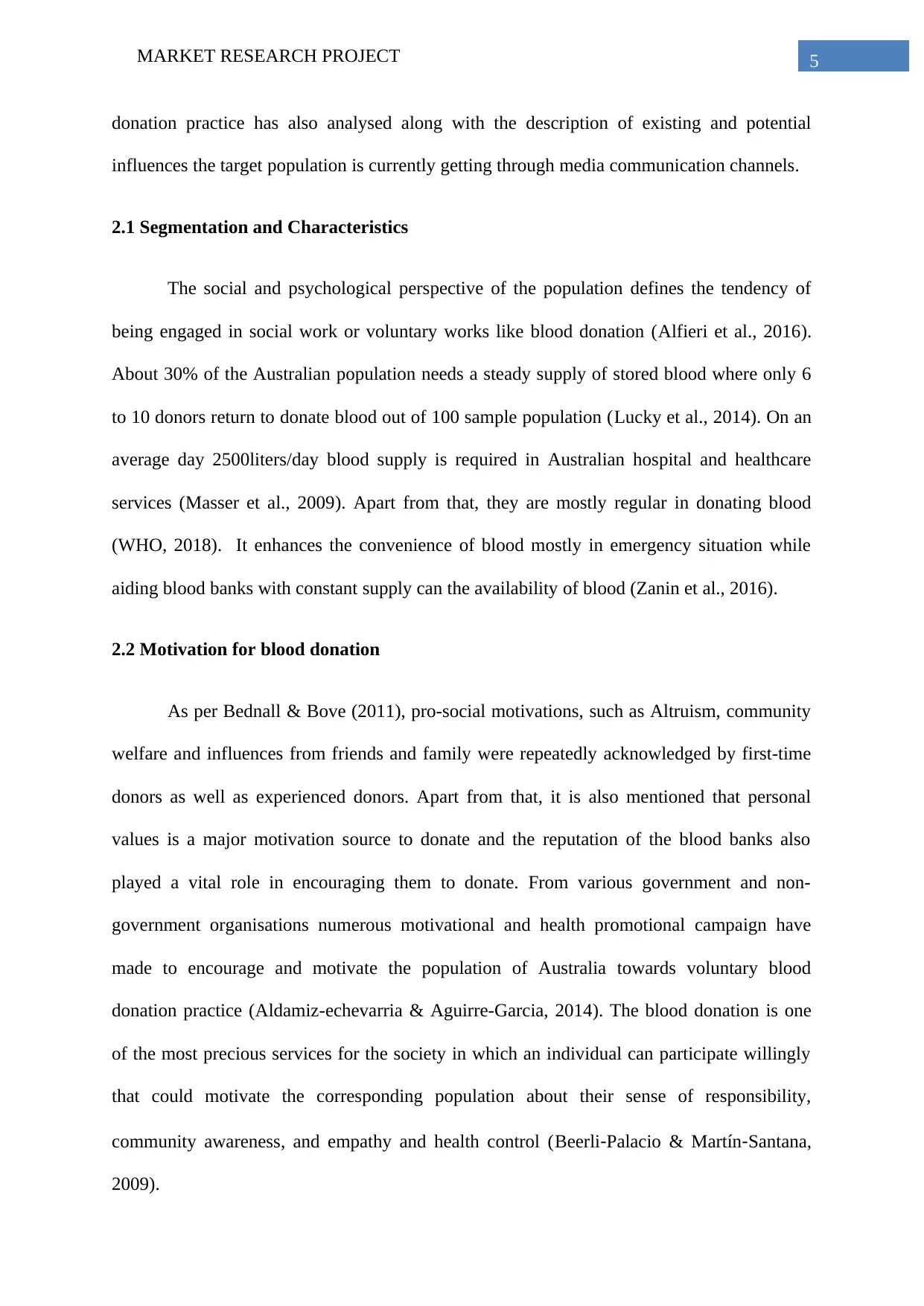
5MARKET RESEARCH PROJECT
donation practice has also analysed along with the description of existing and potential
influences the target population is currently getting through media communication channels.
2.1 Segmentation and Characteristics
The social and psychological perspective of the population defines the tendency of
being engaged in social work or voluntary works like blood donation (Alfieri et al., 2016).
About 30% of the Australian population needs a steady supply of stored blood where only 6
to 10 donors return to donate blood out of 100 sample population (Lucky et al., 2014). On an
average day 2500liters/day blood supply is required in Australian hospital and healthcare
services (Masser et al., 2009). Apart from that, they are mostly regular in donating blood
(WHO, 2018). It enhances the convenience of blood mostly in emergency situation while
aiding blood banks with constant supply can the availability of blood (Zanin et al., 2016).
2.2 Motivation for blood donation
As per Bednall & Bove (2011), pro-social motivations, such as Altruism, community
welfare and influences from friends and family were repeatedly acknowledged by first-time
donors as well as experienced donors. Apart from that, it is also mentioned that personal
values is a major motivation source to donate and the reputation of the blood banks also
played a vital role in encouraging them to donate. From various government and non-
government organisations numerous motivational and health promotional campaign have
made to encourage and motivate the population of Australia towards voluntary blood
donation practice (Aldamiz-echevarria & Aguirre-Garcia, 2014). The blood donation is one
of the most precious services for the society in which an individual can participate willingly
that could motivate the corresponding population about their sense of responsibility,
community awareness, and empathy and health control (Beerli‐Palacio & Martín‐Santana,
2009).
donation practice has also analysed along with the description of existing and potential
influences the target population is currently getting through media communication channels.
2.1 Segmentation and Characteristics
The social and psychological perspective of the population defines the tendency of
being engaged in social work or voluntary works like blood donation (Alfieri et al., 2016).
About 30% of the Australian population needs a steady supply of stored blood where only 6
to 10 donors return to donate blood out of 100 sample population (Lucky et al., 2014). On an
average day 2500liters/day blood supply is required in Australian hospital and healthcare
services (Masser et al., 2009). Apart from that, they are mostly regular in donating blood
(WHO, 2018). It enhances the convenience of blood mostly in emergency situation while
aiding blood banks with constant supply can the availability of blood (Zanin et al., 2016).
2.2 Motivation for blood donation
As per Bednall & Bove (2011), pro-social motivations, such as Altruism, community
welfare and influences from friends and family were repeatedly acknowledged by first-time
donors as well as experienced donors. Apart from that, it is also mentioned that personal
values is a major motivation source to donate and the reputation of the blood banks also
played a vital role in encouraging them to donate. From various government and non-
government organisations numerous motivational and health promotional campaign have
made to encourage and motivate the population of Australia towards voluntary blood
donation practice (Aldamiz-echevarria & Aguirre-Garcia, 2014). The blood donation is one
of the most precious services for the society in which an individual can participate willingly
that could motivate the corresponding population about their sense of responsibility,
community awareness, and empathy and health control (Beerli‐Palacio & Martín‐Santana,
2009).
⊘ This is a preview!⊘
Do you want full access?
Subscribe today to unlock all pages.

Trusted by 1+ million students worldwide
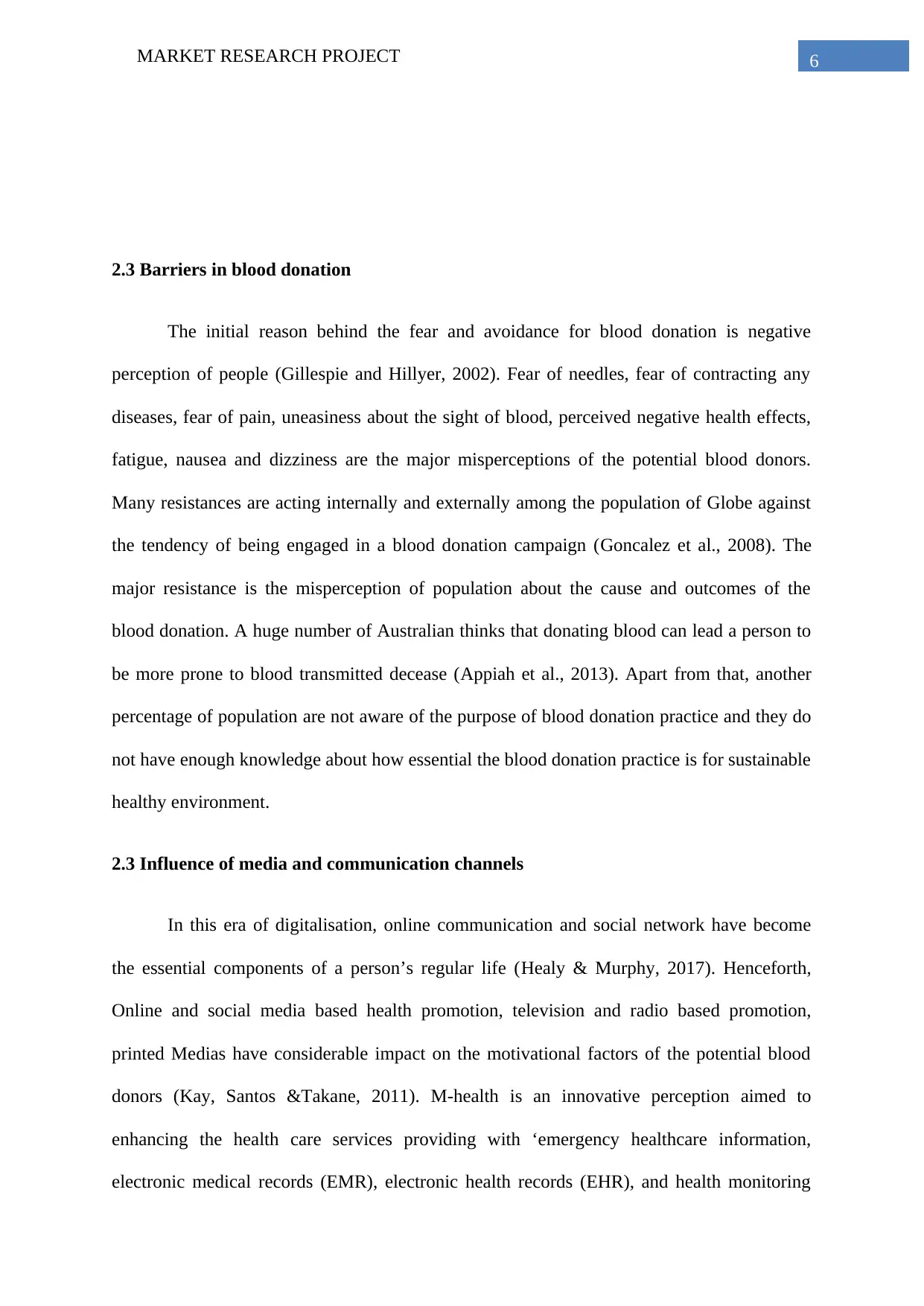
6MARKET RESEARCH PROJECT
2.3 Barriers in blood donation
The initial reason behind the fear and avoidance for blood donation is negative
perception of people (Gillespie and Hillyer, 2002). Fear of needles, fear of contracting any
diseases, fear of pain, uneasiness about the sight of blood, perceived negative health effects,
fatigue, nausea and dizziness are the major misperceptions of the potential blood donors.
Many resistances are acting internally and externally among the population of Globe against
the tendency of being engaged in a blood donation campaign (Goncalez et al., 2008). The
major resistance is the misperception of population about the cause and outcomes of the
blood donation. A huge number of Australian thinks that donating blood can lead a person to
be more prone to blood transmitted decease (Appiah et al., 2013). Apart from that, another
percentage of population are not aware of the purpose of blood donation practice and they do
not have enough knowledge about how essential the blood donation practice is for sustainable
healthy environment.
2.3 Influence of media and communication channels
In this era of digitalisation, online communication and social network have become
the essential components of a person’s regular life (Healy & Murphy, 2017). Henceforth,
Online and social media based health promotion, television and radio based promotion,
printed Medias have considerable impact on the motivational factors of the potential blood
donors (Kay, Santos &Takane, 2011). M-health is an innovative perception aimed to
enhancing the health care services providing with ‘emergency healthcare information,
electronic medical records (EMR), electronic health records (EHR), and health monitoring
2.3 Barriers in blood donation
The initial reason behind the fear and avoidance for blood donation is negative
perception of people (Gillespie and Hillyer, 2002). Fear of needles, fear of contracting any
diseases, fear of pain, uneasiness about the sight of blood, perceived negative health effects,
fatigue, nausea and dizziness are the major misperceptions of the potential blood donors.
Many resistances are acting internally and externally among the population of Globe against
the tendency of being engaged in a blood donation campaign (Goncalez et al., 2008). The
major resistance is the misperception of population about the cause and outcomes of the
blood donation. A huge number of Australian thinks that donating blood can lead a person to
be more prone to blood transmitted decease (Appiah et al., 2013). Apart from that, another
percentage of population are not aware of the purpose of blood donation practice and they do
not have enough knowledge about how essential the blood donation practice is for sustainable
healthy environment.
2.3 Influence of media and communication channels
In this era of digitalisation, online communication and social network have become
the essential components of a person’s regular life (Healy & Murphy, 2017). Henceforth,
Online and social media based health promotion, television and radio based promotion,
printed Medias have considerable impact on the motivational factors of the potential blood
donors (Kay, Santos &Takane, 2011). M-health is an innovative perception aimed to
enhancing the health care services providing with ‘emergency healthcare information,
electronic medical records (EMR), electronic health records (EHR), and health monitoring
Paraphrase This Document
Need a fresh take? Get an instant paraphrase of this document with our AI Paraphraser
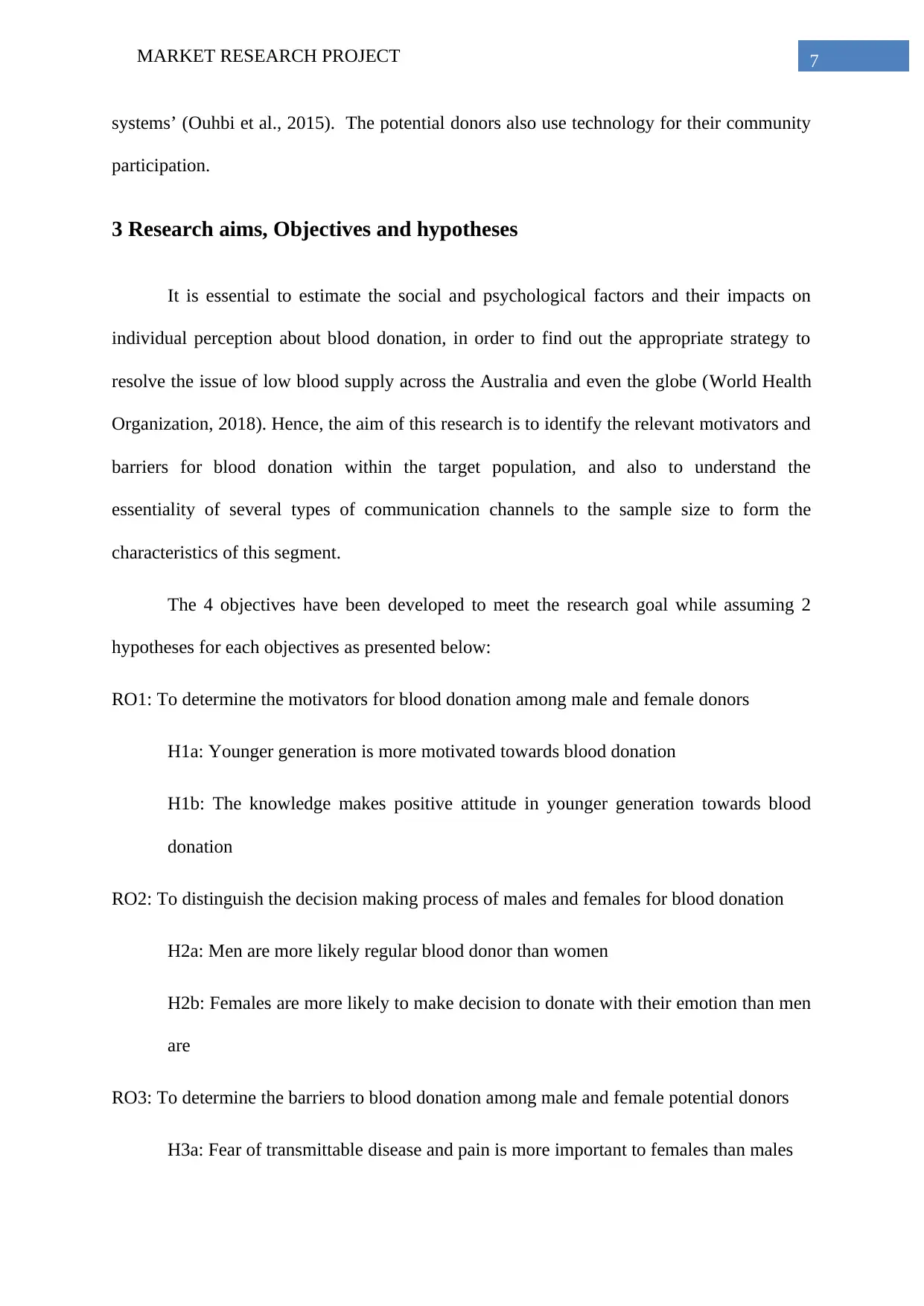
7MARKET RESEARCH PROJECT
systems’ (Ouhbi et al., 2015). The potential donors also use technology for their community
participation.
3 Research aims, Objectives and hypotheses
It is essential to estimate the social and psychological factors and their impacts on
individual perception about blood donation, in order to find out the appropriate strategy to
resolve the issue of low blood supply across the Australia and even the globe (World Health
Organization, 2018). Hence, the aim of this research is to identify the relevant motivators and
barriers for blood donation within the target population, and also to understand the
essentiality of several types of communication channels to the sample size to form the
characteristics of this segment.
The 4 objectives have been developed to meet the research goal while assuming 2
hypotheses for each objectives as presented below:
RO1: To determine the motivators for blood donation among male and female donors
H1a: Younger generation is more motivated towards blood donation
H1b: The knowledge makes positive attitude in younger generation towards blood
donation
RO2: To distinguish the decision making process of males and females for blood donation
H2a: Men are more likely regular blood donor than women
H2b: Females are more likely to make decision to donate with their emotion than men
are
RO3: To determine the barriers to blood donation among male and female potential donors
H3a: Fear of transmittable disease and pain is more important to females than males
systems’ (Ouhbi et al., 2015). The potential donors also use technology for their community
participation.
3 Research aims, Objectives and hypotheses
It is essential to estimate the social and psychological factors and their impacts on
individual perception about blood donation, in order to find out the appropriate strategy to
resolve the issue of low blood supply across the Australia and even the globe (World Health
Organization, 2018). Hence, the aim of this research is to identify the relevant motivators and
barriers for blood donation within the target population, and also to understand the
essentiality of several types of communication channels to the sample size to form the
characteristics of this segment.
The 4 objectives have been developed to meet the research goal while assuming 2
hypotheses for each objectives as presented below:
RO1: To determine the motivators for blood donation among male and female donors
H1a: Younger generation is more motivated towards blood donation
H1b: The knowledge makes positive attitude in younger generation towards blood
donation
RO2: To distinguish the decision making process of males and females for blood donation
H2a: Men are more likely regular blood donor than women
H2b: Females are more likely to make decision to donate with their emotion than men
are
RO3: To determine the barriers to blood donation among male and female potential donors
H3a: Fear of transmittable disease and pain is more important to females than males
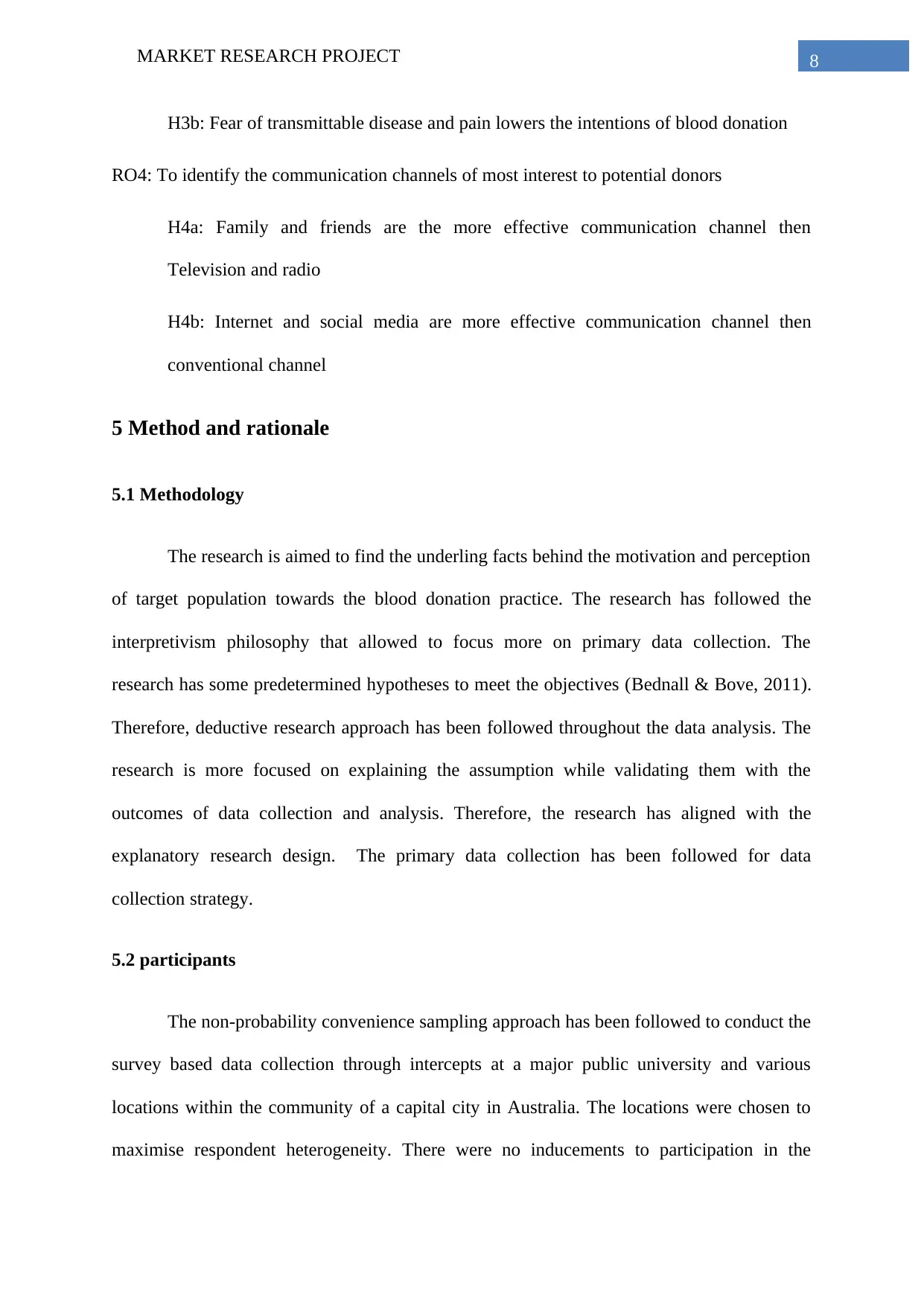
8MARKET RESEARCH PROJECT
H3b: Fear of transmittable disease and pain lowers the intentions of blood donation
RO4: To identify the communication channels of most interest to potential donors
H4a: Family and friends are the more effective communication channel then
Television and radio
H4b: Internet and social media are more effective communication channel then
conventional channel
5 Method and rationale
5.1 Methodology
The research is aimed to find the underling facts behind the motivation and perception
of target population towards the blood donation practice. The research has followed the
interpretivism philosophy that allowed to focus more on primary data collection. The
research has some predetermined hypotheses to meet the objectives (Bednall & Bove, 2011).
Therefore, deductive research approach has been followed throughout the data analysis. The
research is more focused on explaining the assumption while validating them with the
outcomes of data collection and analysis. Therefore, the research has aligned with the
explanatory research design. The primary data collection has been followed for data
collection strategy.
5.2 participants
The non-probability convenience sampling approach has been followed to conduct the
survey based data collection through intercepts at a major public university and various
locations within the community of a capital city in Australia. The locations were chosen to
maximise respondent heterogeneity. There were no inducements to participation in the
H3b: Fear of transmittable disease and pain lowers the intentions of blood donation
RO4: To identify the communication channels of most interest to potential donors
H4a: Family and friends are the more effective communication channel then
Television and radio
H4b: Internet and social media are more effective communication channel then
conventional channel
5 Method and rationale
5.1 Methodology
The research is aimed to find the underling facts behind the motivation and perception
of target population towards the blood donation practice. The research has followed the
interpretivism philosophy that allowed to focus more on primary data collection. The
research has some predetermined hypotheses to meet the objectives (Bednall & Bove, 2011).
Therefore, deductive research approach has been followed throughout the data analysis. The
research is more focused on explaining the assumption while validating them with the
outcomes of data collection and analysis. Therefore, the research has aligned with the
explanatory research design. The primary data collection has been followed for data
collection strategy.
5.2 participants
The non-probability convenience sampling approach has been followed to conduct the
survey based data collection through intercepts at a major public university and various
locations within the community of a capital city in Australia. The locations were chosen to
maximise respondent heterogeneity. There were no inducements to participation in the
⊘ This is a preview!⊘
Do you want full access?
Subscribe today to unlock all pages.

Trusted by 1+ million students worldwide
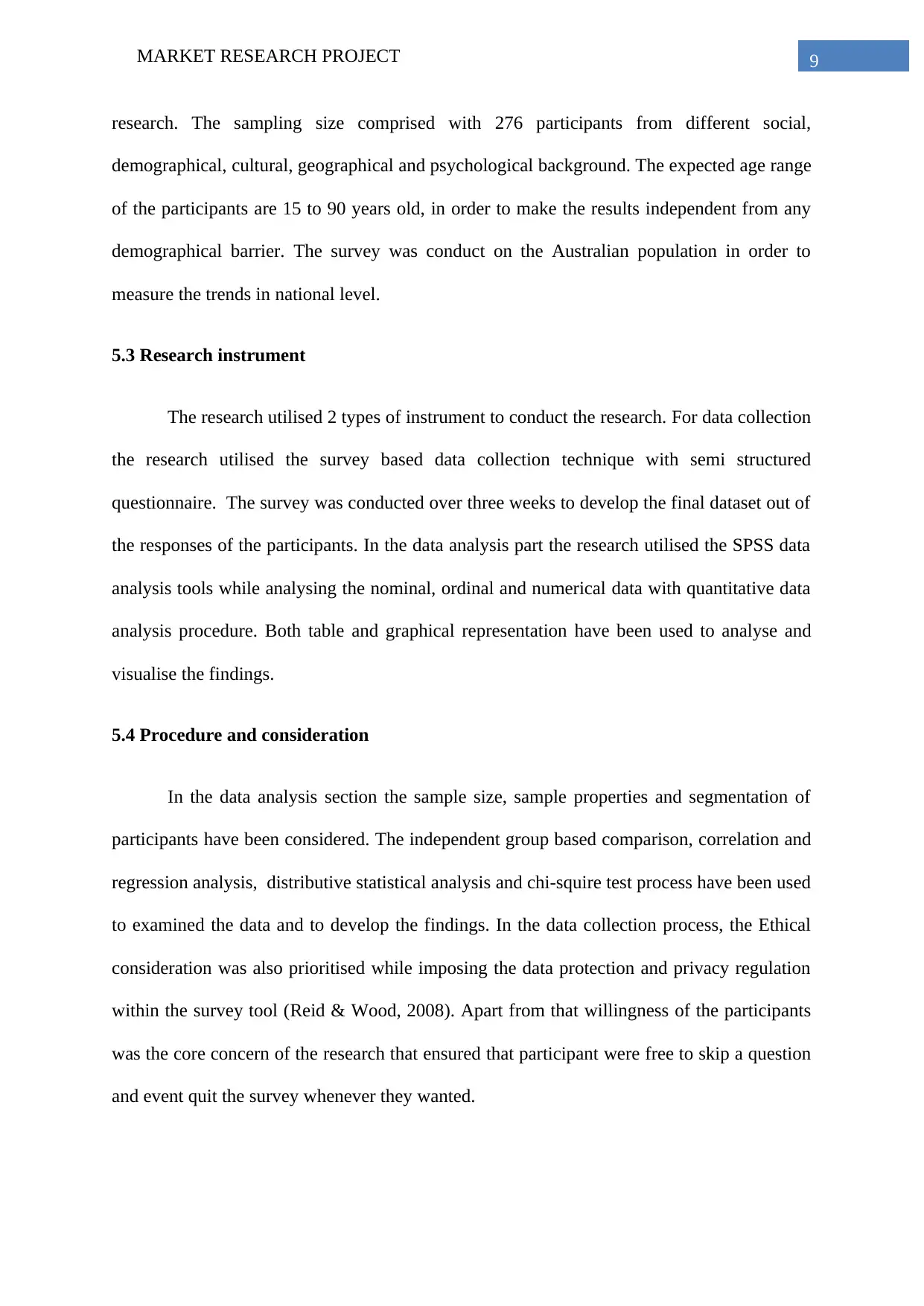
9MARKET RESEARCH PROJECT
research. The sampling size comprised with 276 participants from different social,
demographical, cultural, geographical and psychological background. The expected age range
of the participants are 15 to 90 years old, in order to make the results independent from any
demographical barrier. The survey was conduct on the Australian population in order to
measure the trends in national level.
5.3 Research instrument
The research utilised 2 types of instrument to conduct the research. For data collection
the research utilised the survey based data collection technique with semi structured
questionnaire. The survey was conducted over three weeks to develop the final dataset out of
the responses of the participants. In the data analysis part the research utilised the SPSS data
analysis tools while analysing the nominal, ordinal and numerical data with quantitative data
analysis procedure. Both table and graphical representation have been used to analyse and
visualise the findings.
5.4 Procedure and consideration
In the data analysis section the sample size, sample properties and segmentation of
participants have been considered. The independent group based comparison, correlation and
regression analysis, distributive statistical analysis and chi-squire test process have been used
to examined the data and to develop the findings. In the data collection process, the Ethical
consideration was also prioritised while imposing the data protection and privacy regulation
within the survey tool (Reid & Wood, 2008). Apart from that willingness of the participants
was the core concern of the research that ensured that participant were free to skip a question
and event quit the survey whenever they wanted.
research. The sampling size comprised with 276 participants from different social,
demographical, cultural, geographical and psychological background. The expected age range
of the participants are 15 to 90 years old, in order to make the results independent from any
demographical barrier. The survey was conduct on the Australian population in order to
measure the trends in national level.
5.3 Research instrument
The research utilised 2 types of instrument to conduct the research. For data collection
the research utilised the survey based data collection technique with semi structured
questionnaire. The survey was conducted over three weeks to develop the final dataset out of
the responses of the participants. In the data analysis part the research utilised the SPSS data
analysis tools while analysing the nominal, ordinal and numerical data with quantitative data
analysis procedure. Both table and graphical representation have been used to analyse and
visualise the findings.
5.4 Procedure and consideration
In the data analysis section the sample size, sample properties and segmentation of
participants have been considered. The independent group based comparison, correlation and
regression analysis, distributive statistical analysis and chi-squire test process have been used
to examined the data and to develop the findings. In the data collection process, the Ethical
consideration was also prioritised while imposing the data protection and privacy regulation
within the survey tool (Reid & Wood, 2008). Apart from that willingness of the participants
was the core concern of the research that ensured that participant were free to skip a question
and event quit the survey whenever they wanted.
Paraphrase This Document
Need a fresh take? Get an instant paraphrase of this document with our AI Paraphraser
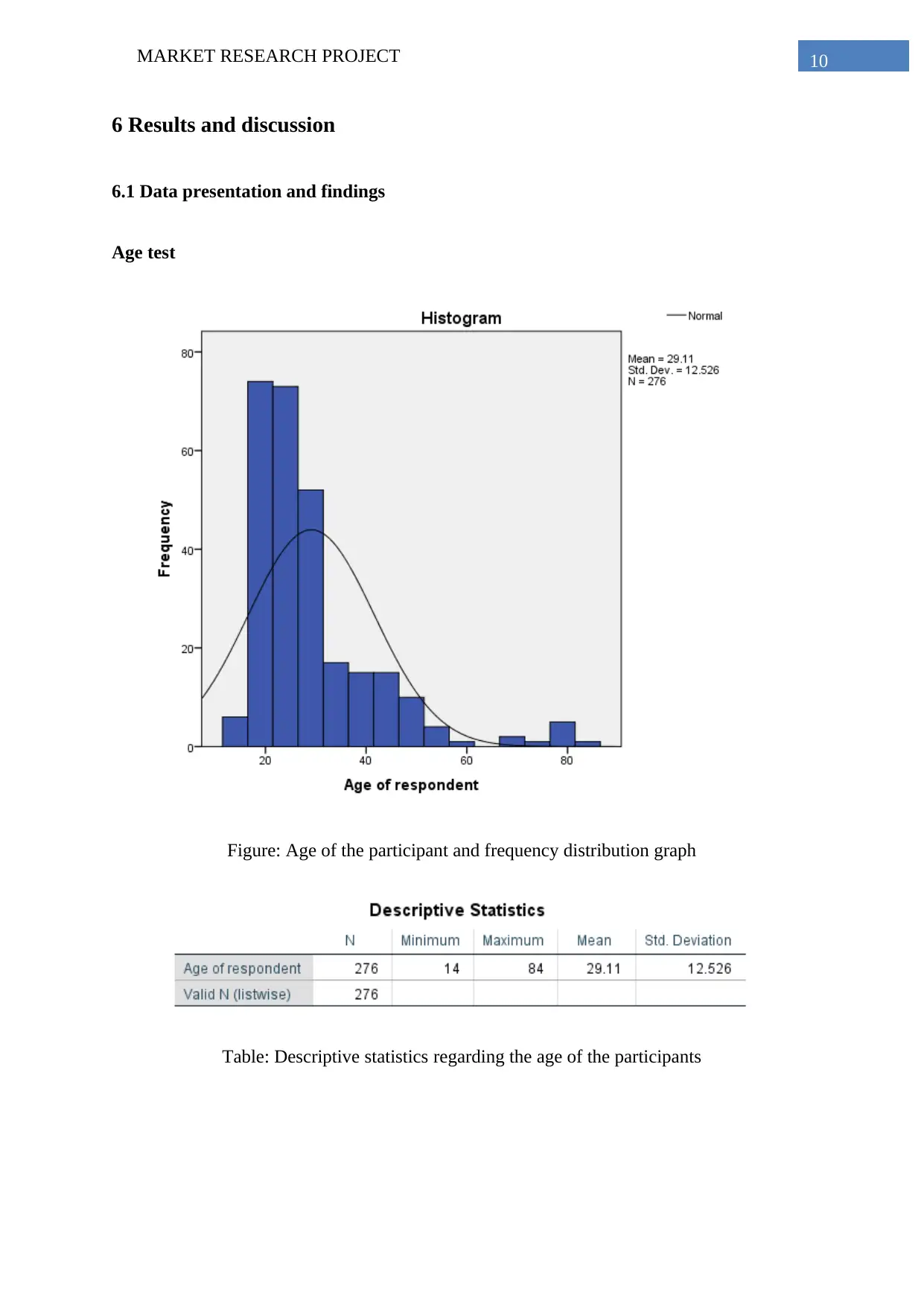
10MARKET RESEARCH PROJECT
6 Results and discussion
6.1 Data presentation and findings
Age test
Figure: Age of the participant and frequency distribution graph
Table: Descriptive statistics regarding the age of the participants
6 Results and discussion
6.1 Data presentation and findings
Age test
Figure: Age of the participant and frequency distribution graph
Table: Descriptive statistics regarding the age of the participants
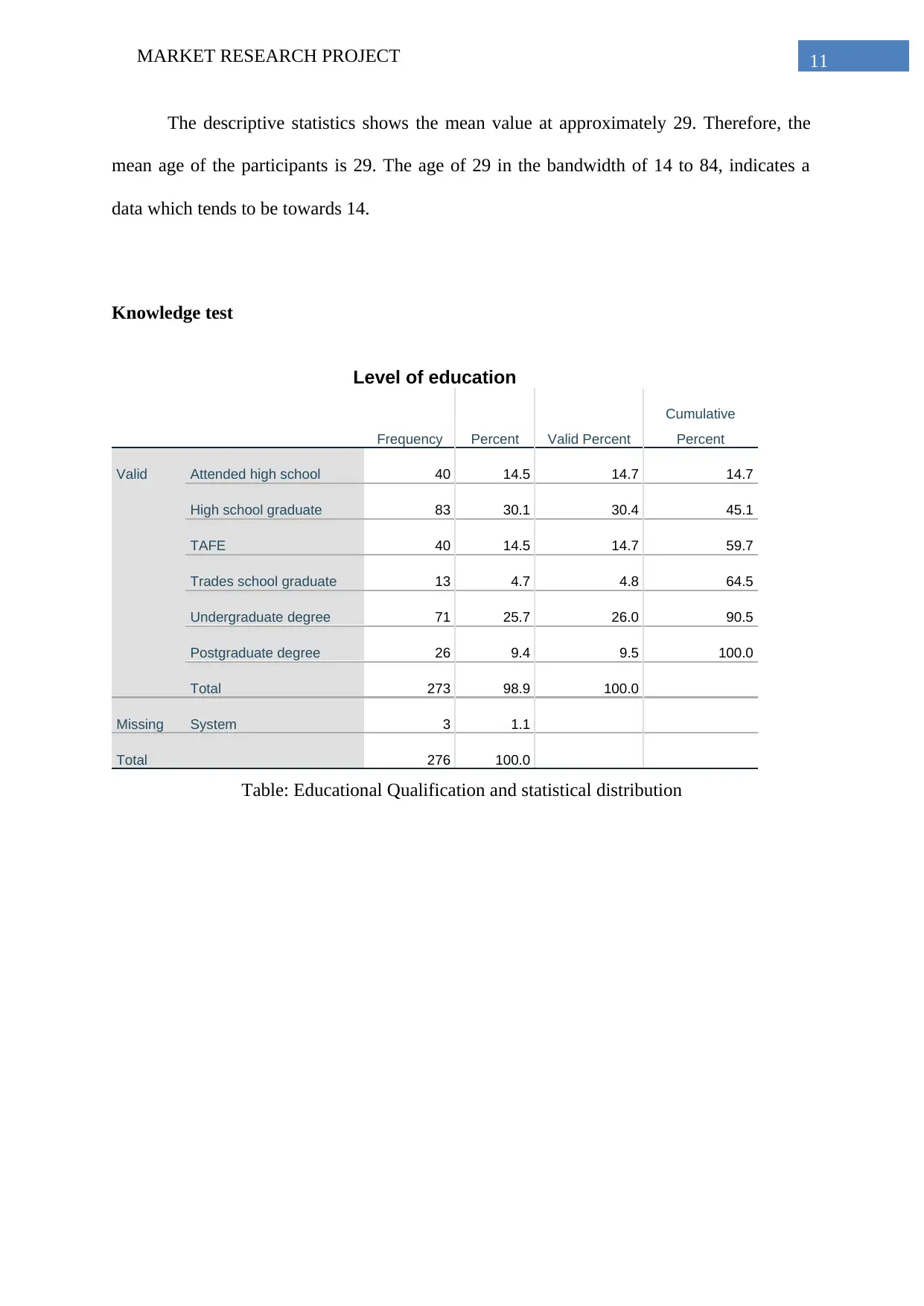
11MARKET RESEARCH PROJECT
The descriptive statistics shows the mean value at approximately 29. Therefore, the
mean age of the participants is 29. The age of 29 in the bandwidth of 14 to 84, indicates a
data which tends to be towards 14.
Knowledge test
Level of education
Frequency Percent Valid Percent
Cumulative
Percent
Valid Attended high school 40 14.5 14.7 14.7
High school graduate 83 30.1 30.4 45.1
TAFE 40 14.5 14.7 59.7
Trades school graduate 13 4.7 4.8 64.5
Undergraduate degree 71 25.7 26.0 90.5
Postgraduate degree 26 9.4 9.5 100.0
Total 273 98.9 100.0
Missing System 3 1.1
Total 276 100.0
Table: Educational Qualification and statistical distribution
The descriptive statistics shows the mean value at approximately 29. Therefore, the
mean age of the participants is 29. The age of 29 in the bandwidth of 14 to 84, indicates a
data which tends to be towards 14.
Knowledge test
Level of education
Frequency Percent Valid Percent
Cumulative
Percent
Valid Attended high school 40 14.5 14.7 14.7
High school graduate 83 30.1 30.4 45.1
TAFE 40 14.5 14.7 59.7
Trades school graduate 13 4.7 4.8 64.5
Undergraduate degree 71 25.7 26.0 90.5
Postgraduate degree 26 9.4 9.5 100.0
Total 273 98.9 100.0
Missing System 3 1.1
Total 276 100.0
Table: Educational Qualification and statistical distribution
⊘ This is a preview!⊘
Do you want full access?
Subscribe today to unlock all pages.

Trusted by 1+ million students worldwide
1 out of 26
Related Documents
Your All-in-One AI-Powered Toolkit for Academic Success.
+13062052269
info@desklib.com
Available 24*7 on WhatsApp / Email
![[object Object]](/_next/static/media/star-bottom.7253800d.svg)
Unlock your academic potential
Copyright © 2020–2025 A2Z Services. All Rights Reserved. Developed and managed by ZUCOL.





